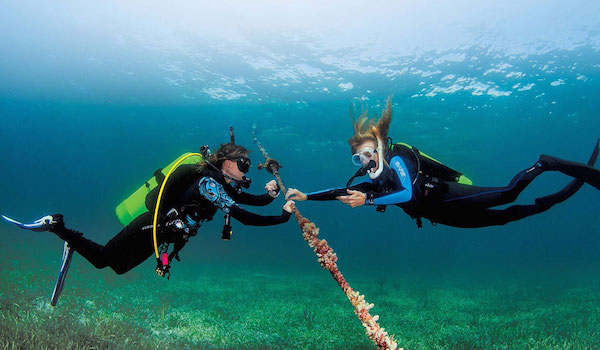Why You Should Never Miss A Safety Stop?
A safety stop although not always mandatory should not be missed and is just as important as properly buoyancy control.

Be smart, make a safety stop on every dive
Each time we dive, additional nitrogen is absorbed in all parts of our body. The deeper we go or longer we stay down, the more nitrogen will be absorbed. In recreational diving, we use the principal of No Decompression Diving.
A No deco dive is a dive where you can ascend slowly but directly to the surface giving your body the time to release the access nitrogen safely. During the surface interval in between dives, the residual nitrogen is then released from your body, and you can plan your next dives accordingly.
What is a safety stop?
Training agencies, like PADI, SSI, and NAUI over the years introduced the concept of a recommended safety stop at 15 feet/5 meters for three minutes for dives below 60 feet /18 meters.
The reason this was introduced is to give your body more time to release the absorbed nitrogen before returning to the surface. While the recommended depth for the safety stop is still shallow, at this depth nitrogen will be released from your tissues at a much faster rate than at 1 ATM at 30 feet / 10 meters, but slower than on the surface.
During your certification as an Open Water Diver, you learned how to use the dive tables.
Two items to note here is that you learned the NDL and remaining pressure groups.
When you look at the dive tables and the NDL for any given depth, you will see that when you reach a time of 5 minutes before the NDL, the recommended safety stop becomes a mandatory safety stop.
You will also see that after these mandatory stops you still have a significant amount of nitrogen left in your system as shown by the amount of surface time needed to return to group A.
If you would ignore these simple rules and you would miss your safety stop you put yourself and your buddy in real danger.
Technical diver’s dive in the realm of decompression dives.
When a technical diver exceeds the NDL that recreational divers see as a limit, they plan decompression stops (Deco Stops). Since they cannot go directly to the surface, they pause giving their body a little more time to release nitrogen before returning to the surface.
Depending on the dive profile, a technical diver may have one or more decompression stops each for a minimum time and a certain depth.
What can happen if you don’t make a safety stop when you should?
If it looks like a duck and quacks like a duck, it is a duck. The recommended and mandatory safety stops are actually deco stops. A pause to move your body’s nitrogen content away from the limit and give you a safer margin for error.
First of all, you should plan your dive so that the safety stop is always a part of your dive. Second; you should dive well within your limits and those that are set for recreational diving.
When you stick to those rules and you for some reason miss a stop, your should be okay but it is recommended you stop your dives for the day, and you monitor yourself or your buddy for symptoms of decompression sickness.
The safety stop is designed to give you a greater margin to avoid decompression sickness, those three minutes significantly reduce your chance of suffering from it.
If you do choose to go beyond these limits and you miss your stop because you do not have enough air left, or you freak out for some reason, and you bolt up to the surface you are probably in deep trouble. If you are lucky, you are in a location where you can get to a hyperbaric chamber quickly which increases the likelihood of a full recovery.
If you are diving in a remote area and you have a severe barotrauma, it could take a while before you can be evacuated to be treated by specialists who will do anything they can to save your life.
Plan your dive and dive your plan
Add the 3-minute safety stop your dive plan, keep an eye on your gauges to monitor your depth, bottom time and air consumption. If you exceed your scheduled bottom time, start a slow but controlled ascent immediately.
When you have sufficient air supply, pause half way to the surface for 30 seconds or so and then continue to the mandatory safety stop for 3 minutes at 15 ft. Doing so will give your body extra time to off-gas, and this will increase the safety margins.
Also read: Why do diving accidents happen and how you ca avoid them
If you are using a dive computer, it will tell you when a safety stop is needed, however not all will suggest the safety stop at 15 feet, do it anyway.
Bottom line; recreational diving should always be done within the non decompression limits. Diving beyond these limits needs proper training. Use common sense, dive within your personal limits, plan your dive and dive your plan and have fun and don’t become “that” diver.
Did you ever miss a safety stop? Let us know in the comments below
This article is written by RUSHKULT, the online booking platform for Scuba Diving. Visit the RUSHKULT platform to book your next Scuba Dive training, guided trip, and accommodation. [the_ad id="10253"]
Leave a Comment